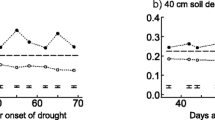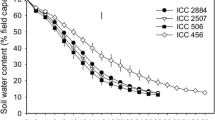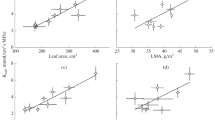Summary
Lolium perenne, was grown in sand pot culture in a controlled environment cabinet. A factorial arrangement of three nitrogen treatments, two soil water levels and two light intensity treatments were applied and the plants were harvested at 33, 46 and 60 days from germination.
Growth analysis showed that nitrogen and water treatments affected dry-weight production by their effects on leaf area duration while the dry-weight response to increased light intensity was due to an increase in leaf area duration and net assimilation rate. The effects of nitrogen and water on net assimilation rate were small.
The rate of transpiration per unit leaf area increased with light intensity associated with greater stomatal aperture and a greater vapour pressure deficit. Nitrogen supply had no effect on the rate of transpiration per unit leaf area, while increase in water supply slightly increased transpiration rate. The effects of nitrogen and water on total water loss were largely due to their effects on leaf area duration. Light intensity also affected water loss by its influence on leaf area duration.
The root weight duration (integral of root weight with respect to time) was used in interpreting the nitrogen uptake by the plants. Nitrogen uptake was a function of external nitrogen concentration and at the higher water content, uptake per unit root weight duration was reduced. This effect was attributed to nutrient dilution at the higher water content. Further analysis indicated that the plants were, in general, unable to take up nitrogen at the rate at which it was convected to the root system.
Similar content being viewed by others
References
Alvim, P. de T. and Havis, J. R., An improved infiltration series for studying stomatal opening as illustrated with coffee. Plant Physiol.29, 97–98 (1954).
Broyer, T. C. and Hoagland, D. R., Metabolic activities of roots and their bearing on the relation of upward movement of salts and water in plants. Am. J. Botany30, 165–259 (1943).
Denmead, O. T. and Shaw, R. H., The effects of soil moisture stress at different stages of growth on the development and yield of corn. Agron. J.52, 272–74 (1960).
Kuiper, P. J. C., The effect of environmental factors on the transpiration of leaves, with special reference to stomatal light response. Meded. Landbouwhogeschool Wageningen61, (7) 1–49 (1961).
Luxmoore, R. J. and Millington, R. J., The growth of perennial ryegrass (Lolium perenne L.) in relation to water, nitrogen and light intensity. Part I. Effects on leaf growth and dry weight. Plant and Soil34, 269–281 (1971).
Prescott, J. A., The responses of the growth of pastures to temperature. Australian J. Sci.11, 24–25 (1948).
Watson, D. J., The physiological basis of variation in yield. Advances in Agronomy4, 101–145 (1952).
Author information
Authors and Affiliations
Rights and permissions
About this article
Cite this article
Luxmoore, R.J., Millington, R.J. Growth of perennial ryegrass (Lolium perenne L.) in relation to water, nitrogen, and light intensity. Plant Soil 34, 561–574 (1971). https://doi.org/10.1007/BF01372813
Received:
Issue Date:
DOI: https://doi.org/10.1007/BF01372813




